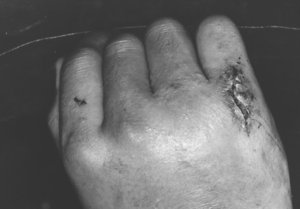
Human Bites
 A human bite that has broken the skin.
Reproduced with permission from: Griffin LY (ed): Essentials of Musculoskeletal Care, 3rd Edition. Rosemont, IL. American Academy of Orthopaedic Surgeons, 2005.
Human bite wounds may not seem dangerous, but the risk of infection is high. These wounds contain very high levels of bacteria. Even though the wound may appear minor, an infection can lead to a severe joint infection. About one third of all hand infections are caused by human bite wounds. These infections can move quickly and cause major complications, including destruction of the joint, if not treated promptly.
Causes
A human bite that has broken the skin.
Reproduced with permission from: Griffin LY (ed): Essentials of Musculoskeletal Care, 3rd Edition. Rosemont, IL. American Academy of Orthopaedic Surgeons, 2005.
Human bite wounds may not seem dangerous, but the risk of infection is high. These wounds contain very high levels of bacteria. Even though the wound may appear minor, an infection can lead to a severe joint infection. About one third of all hand infections are caused by human bite wounds. These infections can move quickly and cause major complications, including destruction of the joint, if not treated promptly.
Causes
A human bite wound can be caused directly--a child bites another child. A human bite wound also can be caused indirectly--a hand strikes a tooth, breaking the skin on the hand. A punch to the mouth can result in an indirect bite injury at the knuckle joint (metacarpophalangeal joint).
SymptomsIn some cases, the bite will not break the skin, but may cause damage to underlying tendons and joints. If the skin is broken, there is the possibility of infection as well as injury to joints, tendons, and nerves. An injury to the top of the hand can result in significant swelling within hours.
Signs of an Infection
- Warmth around the bite wound
- Swelling
- Pain
- A pus discharge
Signs of Tendon or Nerve Damage
- An inability to bend or straighten the finger.
- A loss of sensation over the tip of the finger.
Be prepared to tell your doctor how you got the bite. During your visit, your doctor will perform an examination.
Your doctor will measure the wound, note its location, and check for signs of nerve or tendon damage. He or she may examine your arm for red lines, which are a sign of a spreading infection.
Your doctor may order x-rays and a blood test. In addition, he or she may give you a tetanus shot and prescribe antibiotics.
You may need to return to your doctor's office a day or two after your first visit. At that time, your doctor can confirm that you have not developed an infection.If your tendons or nerves have been injured, you may need to see a specialist for additional treatment. Surgery may be necessary if you have an infected joint or tendon.
TreatmentBites can transmit diseases to another person. These may even include the human immunodeficiency virus (HIV), the hepatitis B and C virus, and syphilis. See a doctor within 24 hours of the injury if the skin is broken.
Superficial Bites
If you have a bite, follow these precautions.
- Do not put the bitten area in your mouth. This adds bacteria into the wound.
- If the skin around the wound is not broken, wash the wound thoroughly. Use soap and water or an antiseptic, such as hydrogen peroxide.
- Apply an antibiotic ointment to the area and cover with a nonstick bandage.
- Watch the area carefully. Are there signs of damaged nerves or tendons? If the fingers cannot be straightened or bent or if there is numbness, seek medical help.
Deep Wounds
- If the skin around the wound is broken and bleeding, apply direct pressure with a clean, dry cloth.
- Elevate the area.
- Do not clean a wound that is actively bleeding.
- Cover the wound with a clean dressing and seek medical help.
To prevent complications from a deep wound, get medical attention within 24 hours of being bitten. Surgery is indicated for suspected joint or tendon infection.
Source: http://orthoinfo.aaos.org/topic.cfm?topic=A00003
